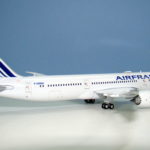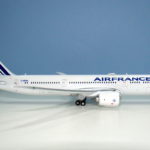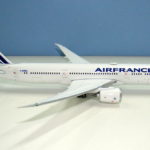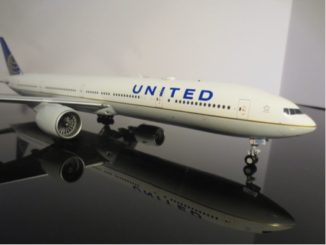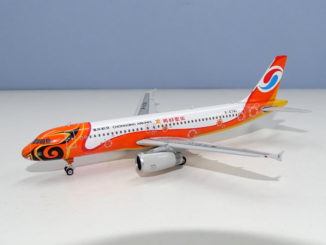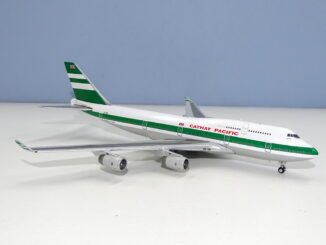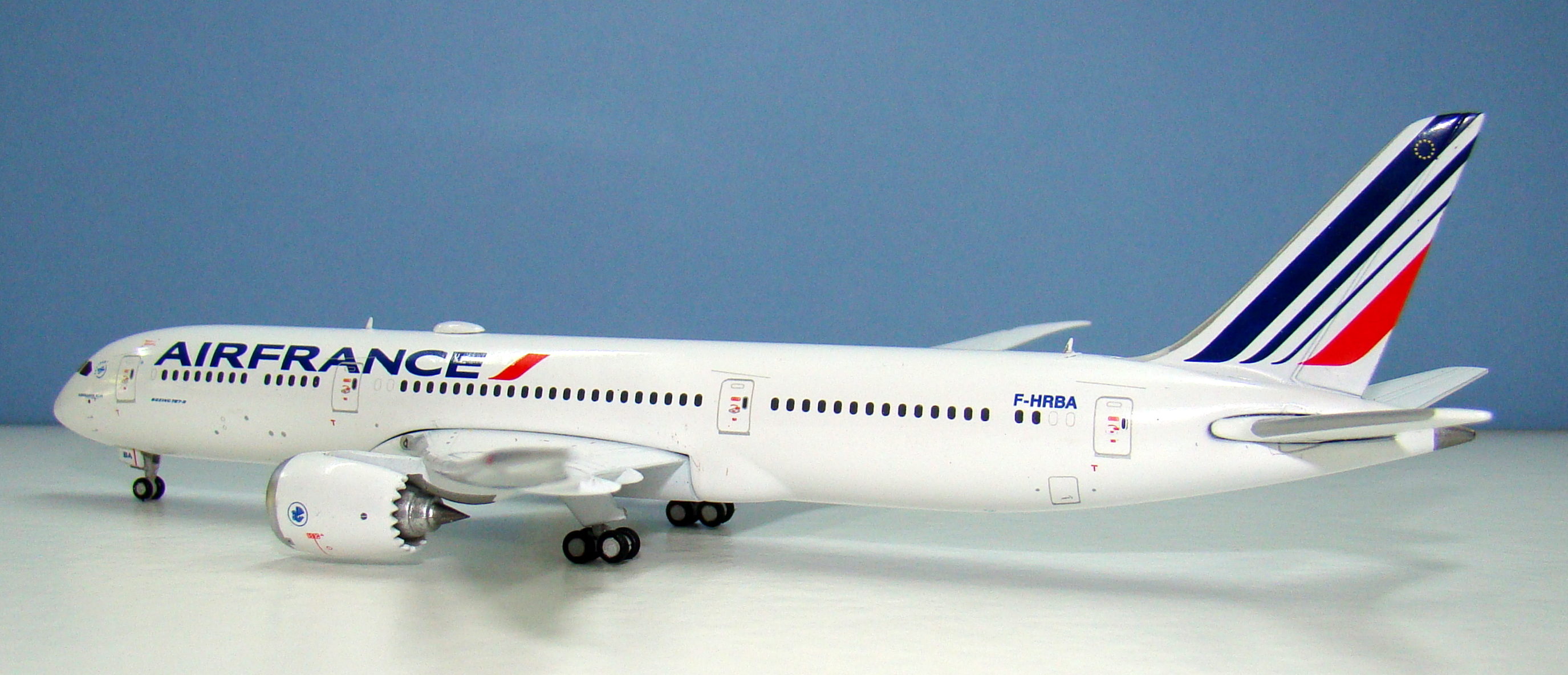
After reviewing the A350 in my first review it’s time to take a look at the competition in the form of the 787-9, again from Gemini Jets. Air France has had a long history buying Boeing widebodies, despite Airbus being partially French owned, and is a huge 777 operator, with 70 in the fleet. As such it isn’t a surprise that they also ordered 787s. The 787-9, like its shorter brother the 787-8, was much delayed, but first delivery was finally made on July 8, 2014 to Air New Zealand. By January 2017 193 787-9s were in service and the type is selling well. In 1/400 scale the 787-9s have also been rolling off the production line with both Phoenix and JC Wings/Gemini having moulds for the type. Let’s look in detail at Gemini’s offering.
THE REAL THING

The combined Air France-KLM Group have ordered 18 787-9s and 7 787-10s direct with a further 12 787-9s leased from AerCap. Air France’s first aircraft was one of the leased examples, being delivered from Seattle on November 29, 2016 as F-HRBA. KLM by February had 8 787-9s already in service with 7 more on order (plus the 787-10s) whilst Air France looks like it’ll take 16 787-9s, but for now has just one in service.
The French 787-9s will all be configured in a three class layout seating 30 business, 21 premium economy and 225 economy class seats. This 276 passenger configuration is less than the 293 seats in Lufthansa’s slightly larger A350-900s. It does introduce Air France’s new Premium economy seats and the aircraft are also fitted with onboard Wi-Fi.
Service entry for the first 787-9 has taken the usual path of short testing flights like Paris-London with the first regular service between Paris and Cairo on January 9. Proper 787 stage length routes are not scheduled to begin until May 1 after the 2nd 787 arrives and will initially connect Paris and Montreal. Prior to the Cairo service a series of four ‘exceptional’ flights within France were undertaken on January 7 and 8. These included Champagne and festive dining, surprise gifts and certificates. The flights took in Corsica and the Mediterranean, the South West and Gascony, Brittany and a flight around France.
Despite Air France’s continuing issues with profitability it’s good to know they can still lay on the style and class, and the 787-9 looks like it’ll be a good fit for them for many years to come.
THE MODEL
The format for my reviews is to split them into three key areas:
- The mould of the aircraft
- The paint and livery
- Printing and quality control
Each can get a maximum score of 10 for a section giving a maximum score of 30.
THE MOULD
Seeing as the 787, like the A350, is the immediate future of most long haul travel their moulds take on an increased importance for the manufacturers. With Phoenix and JC Wings/Gemini often releasing the same models the mould is a critical factor in which you buy. As I said I think JC Wings wins the A350 battle, but in the 787 arena Phoenix cleans up.
That’s not to say the Gemini mould is poor, it isn’t. In fact it is pretty good. It certainly captures the look and feel of the 787-9 well. I have no issues with the shape of the mould at all. The areas where it falls down in comparison to the Phoenix mould are twofold – seams and aerials.

The JC Wings / Gemini mould is a cradle fit mould, whereas the Phoenix has slot in wings. This means there is a seam. Ahead of the wings it follows the wing join bulge, at least at first, but at the rear it is a crude square cut-off. This sort of thing doesn’t tend to annoy me, especially on older moulds, but when your competitor has a good seamless mould you’ve got a problem. The seam at the top of the wing also follows the wing line, whereas the bulge on the real thing does not – so that is incorrect.
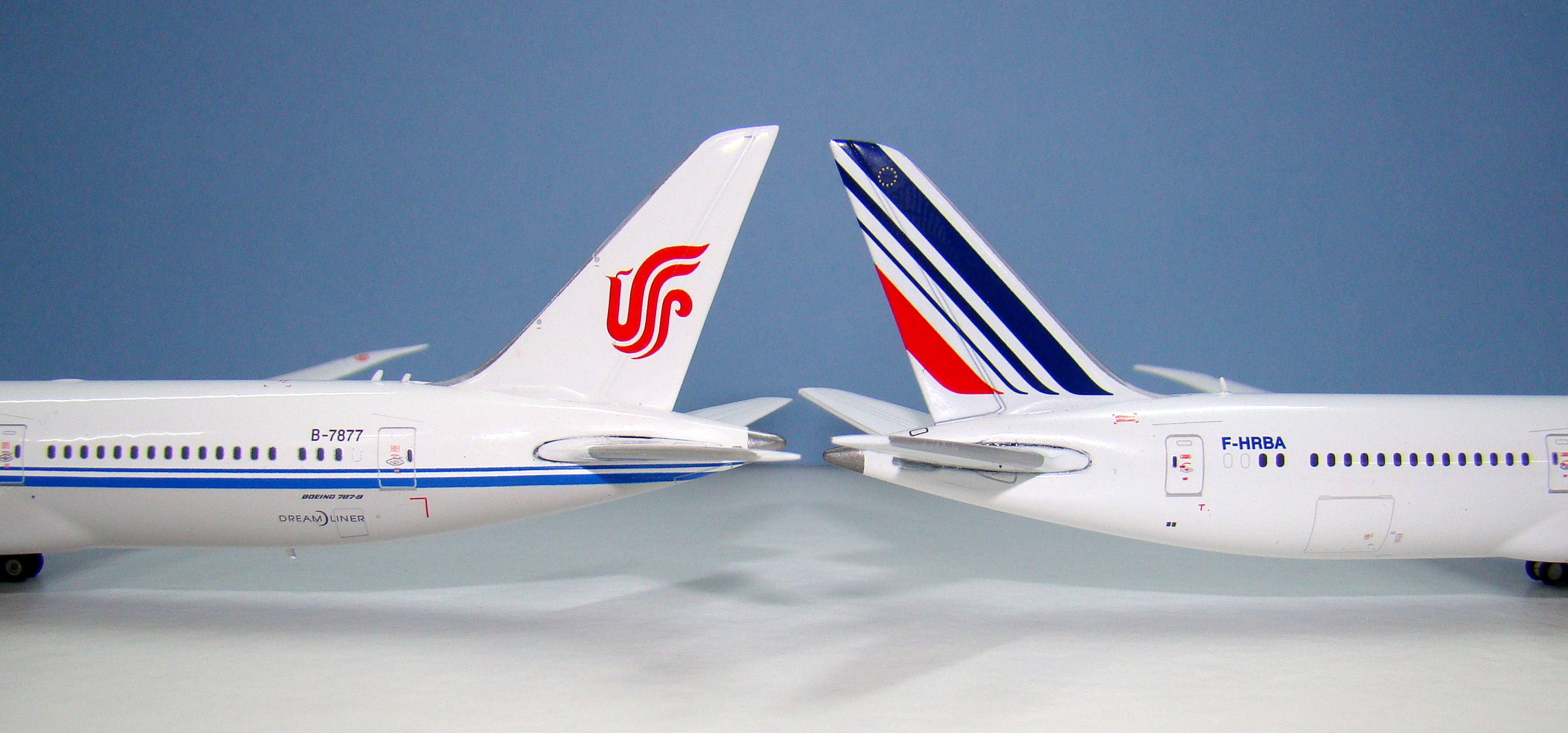
Like on the A350 mould JC Wings / Gemini seem to have made a conscious decision to limit the aerials and bumps. I can understand this but then why do they put so many on their smaller moulds (where they are often too large); and as with the seam if Phoenix have them more correctly detailed then Gemini have an issue. In this case Gemini only includes two of the three antennae atop the fuselage and miss out the quite large one on the rear underside. They obviously include the large satnav dome but then only outline the post-wing bump and smaller ones forward. Phoenix has all the aerials and the rear bump on their mould.
Looking at the undercarriage again this mould comes up short. Here it is the wheelhubs. They are the wrong colour (grey rather than silver) but also poorly detailed compared to the real thing and the Phoenix. In isolation the JC Wings / Gemini 787-9 mould looks very good; however it pales in comparison to the Phoenix mould. That doesn’t mean I wouldn’t buy it, but it is simply not as good.
SCORE – 7
PAINT & LIVERY
Air France invented the “Eurowhite” style of livery way back when they introduced the barcode flag scheme in 1976. Nowadays all white fuselages are ten a penny, but back then AF was a style leader and I imagine that amongst a sea of cheatlines the scheme really stood out. A major update to the scheme didn’t occur until February 2009. I guess you could call it a new scheme but I tend to think of it as a tasteful update to the original. The tail was simplified by turning 5 lines to 4 and giving them a small flourish at their bottoms. The titles were also updated to one word – AIRFRANCE, with a new swoosh logo next to them. That’s about it. There isn’t much more you can do when everything else is white! Still it is a classy update keeping the best of the old scheme and modernising it. The only thing I’m not sure about is the swoosh thingy; I’d have preferred if they’d used an updated version of the old seahorse.

As with the Lufthansa scheme on the A350 it ought to be an easy one to reproduce because it’s so simple, however any mistakes will no doubt be more obvious too. Starting at the tail of the Boeing things look excellent; the circle of EU stars is clear and well printed, much better than the Phoenix version. The white fuselage base colour is fine and the seahorse logo on the engines well printed also.
It is on the fuselage that issues appear. Some are tiny – for example the registration is printed too close to the window line. Its top should be above the door top, not level with it. The biggest problem is the main titles. The colours and shape are ok but they are simply too short. Air France increased the height of the titles on the 787s especially, but it doesn’t look like Gemini noticed this. You can see this most obviously on the A in FRANCE where it passes the door top . They are a few millimeters too short. This may not sound much but compared to photos of the real thing it looks quite obvious. As a standout feature of the 787 livery it is poor that Gemini has missed this. Phoenix got it right – it is a major fail for Gemini.
SCORE – 6
PRINTING & QUALITY CONTROL
Once again Donald at DGPilot (https://www.dgpilot.com/) has checked this model before sending so, at least at a high-level, all the bits are attached. I continue to be impressed by the printing quality of the Gemini Jets I’m receiving. The detail is outstanding, everywhere except on the fuselage cradle underneath. Here the paint is laid on too thickly so that it is hard to see the outline of the undercarriage doors and there is little other printed detail. Similarly the underside of the wings is pretty much just white paint, aside from the registration. On the real thing there are intakes at the wingroot and these are missing on the Gemini (they don’t look like they are on the Phoenix either).
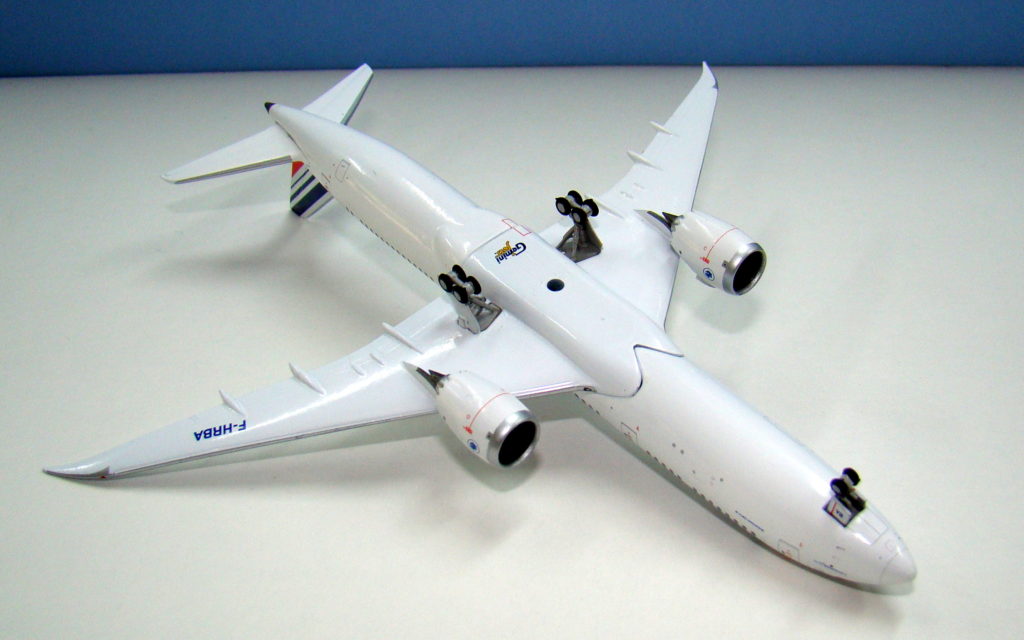
On the quality side of things this is a good effort aside from 3 items. There is a very small mark on the port side wing root, probably related to the human effort to attach it. This is almost un-noticeable and I don’t see any other finger marks. More concerning is the fitment of the satnav dome. This is fine on the port side but poor on the starboard, with a noticeable gap between it and the fuselage. Lastly the nosegear tyres are poor. The finish of the hubs is rough and the tyres have some tabbing. With the added lack of detail to the rims it rather stands out in close up.
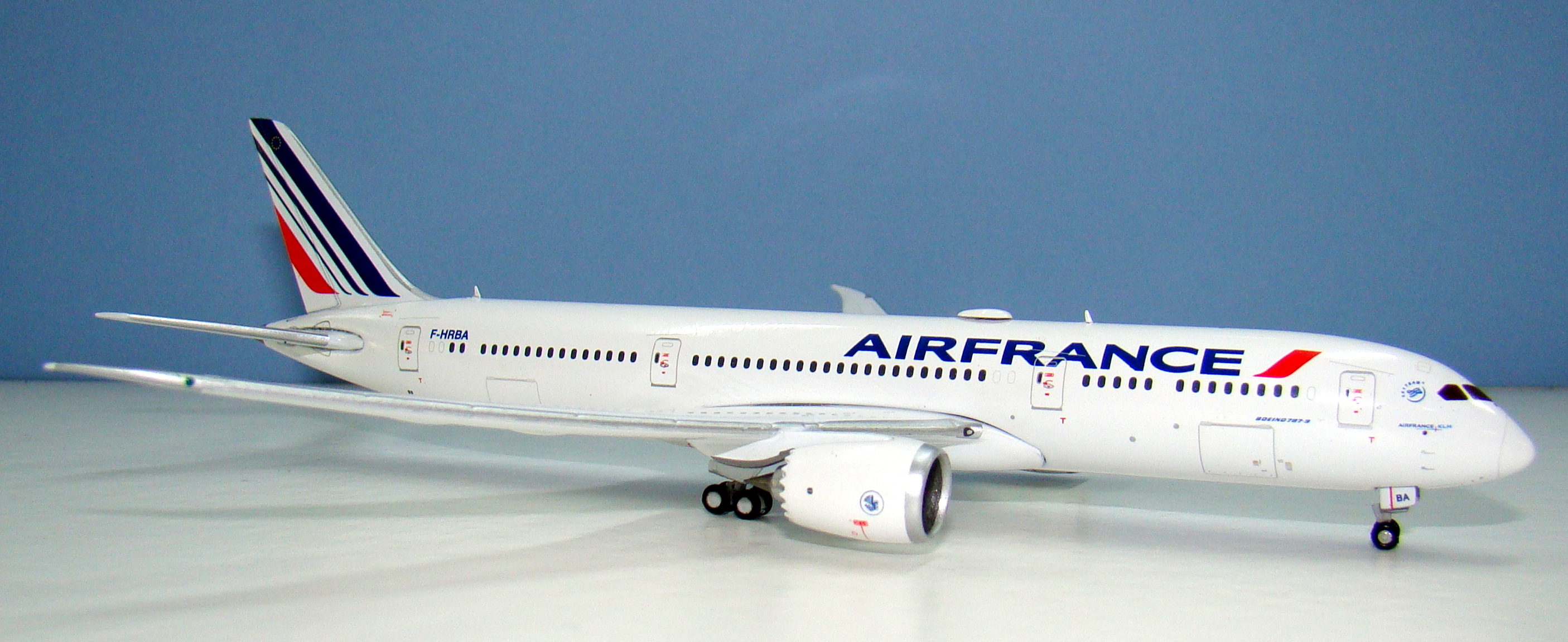
Although the overall finish is crisp the dome fit and nosegear are rather bothersome.
SCORE – 7
CONCLUSION
Once again at first glance this model appears very good, but on inspection points keep on falling off, until it rather limps across the finish line with the minimum acceptable score (of 20). A pattern seems to be forming with Gemini, whereby the printing is very good in detail but the model is damaged by poor livery research, decent moulds weakened in critical areas and some poor attention to quality. I get the feeling all the manufacturers may be just as bad so perhaps it’s unfair to dump on Gemini in particular. Nevertheless this is the first review where I can’t recommend the model, as the Phoenix is clearly superior across the board.
FINAL SCORE – 20/30






